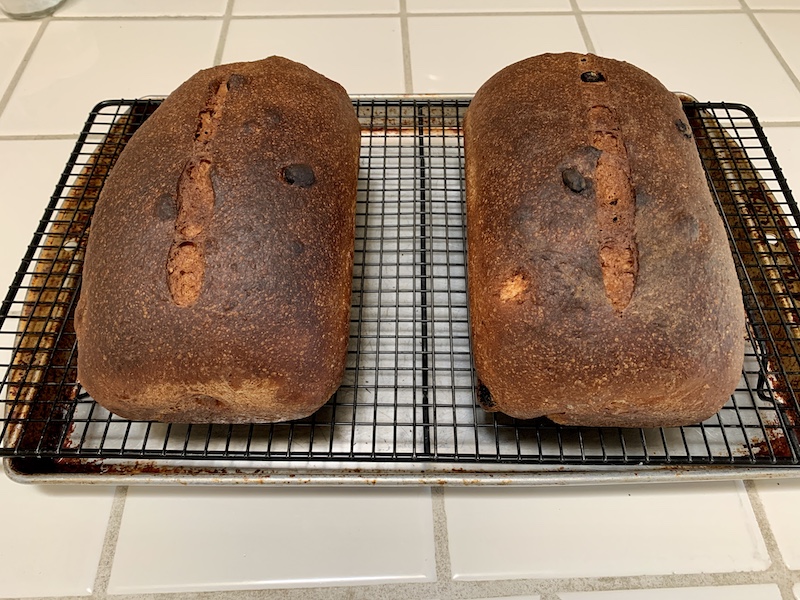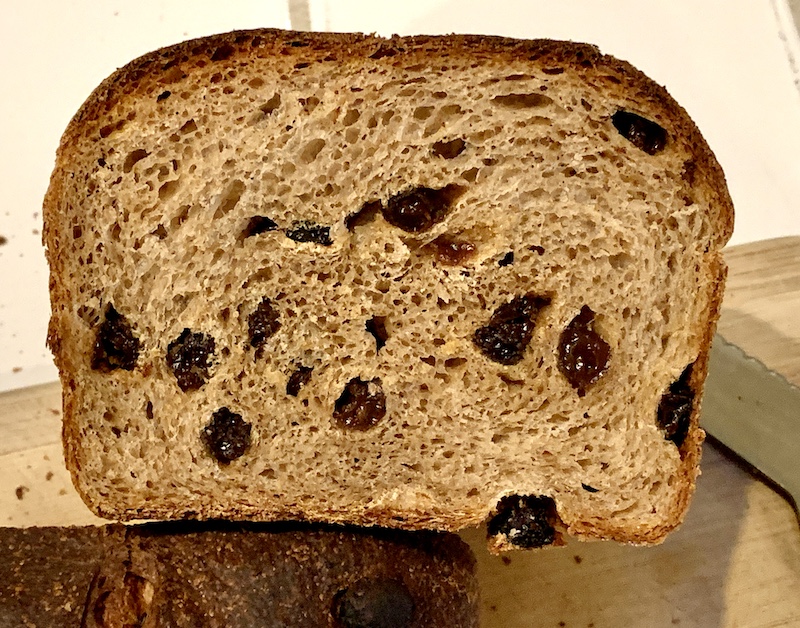
Oatmeal Bread with Cinnamon and Raisins from Hamelman's "Bread"

Today I baked a couple loaves of Hamelman's Oatmeal Bread with Cinnamon and Raisins. It was my third bake of this recipe. The only modification I made was, while I had used AP flour before, this time I used King Arthur Baking "Bread Flour." The higher-gluten flour was naturally a bit thirstier, and it ended up with a more open crumb. It was a bit chewier, but the flavor was unchanged.
One glitch was that the loaves were about 3/4 proofed when I had to leave for a dental appointment, so I stuck them in the fridge. When I got home about to hours later, I thought the loaves were borderline over-proofed, but after baking, cooling, slicing and tasting, I find no fault with them.
This is a very nice toast bread. We'll have it for breakfast spread with home-made almond butter. Yum!
Here's the formula and process:
Oatmeal Bread with Cinnamon and Raisins
from Jeffrey Hamelman’s “Bread,” 3rd Edition
Ingredients | Baker’s % | Wt for 1 large loaf | Wt for 2 large loaves |
Bread Flour | 75 | 208 | 416 |
Whole Wheat Flour | 25 | 69.3 | 138.6 |
Rolled Oats | 16.5 | 45.76 | 91.52 |
Water | 62.5 | 173.3* | 346.6** |
Milk | 11 | 30.5 | 61 |
Honey | 7.5 | 20.8 | 41.6 |
Vegetable Oil | 7.5 | 20.8 | 41.6 |
Salt | 2.2 | 6.1 | 12.2 |
Instant Yeast | 3.5 | 9.7 | 19.4 |
Cinnamon | 1.5 | 4.16 | 8.32 |
Raisins (soaked and drained) | 33 | 91.5 | 183 |
Total | 245.2 | 679.92 | 1360 |
Note: For 8x4 “ pans, scale loaves to 510g. For 9x5” pans, scale to 680g.
Procedures
- The night before baking, soak the oats in an equal weight of water (from the total water). Rinse and drain the raisins.
- Add all the ingredients except the raisins to the mixer bowl. Mix for 3 minutes on Speed 1, then for 3-8 minutes at Speed 2 to moderate gluten development. The dough should be moderately loose and slightly tacky. Note: Don’t forget to subtract the water used to soak the oats from the water added when mixing.
- Add the raisins and mix at Speed 1 to incorporate them.
- Transfer the dough to a lightly floured board and knead briefly, then form a ball.
- Transfer the dough to a lightly oiled bowl and cover.
- Bulk ferment until dough is doubled (90 to 120 min.) Fold dough once after 1 hour. Note: Alternatively, the dough can be cold retarded after mixing.
- Divide the dough and pre-shape into rounds. Note: Can be divided and shaped for hearth baking or as rolls. Rest pieces for 10-15 minutes.
- Shape as pan loaves (or otherwise, as desired) and place smooth side up in oiled bread pans. Place pans in plastic bakery bags and seal or cover them with a cloth. Optionally, dampen the loaves’ and sprinkle with rolled oats.
- Proof at 76ºF until loaves peek above the pan rims (30-90 min.)
- Bake with steam at 450ºF. After 15 minutes, remove the steaming apparatus and lower the oven temperature to 430ºF (If the loaves are browning too fast, lower the oven temperature another 10-F. Note: 510g loves will bake in 30-35 minutes, total. 680g loaves will take up to 40 minutes total.
* 45.8g water to soak the oats. 127.5g water for the final mix.
** 91.5g water to soak the oats. 255.g water for the final mix.


Enjoy!
David


Comments
Thanks for sharing, an interesting recipe to add to my "to bake" list. Do appreciate all of the recipes you share here, and I think of them as "David approved" so know that they'll turn out well.
Would be interested to hear your thoughts if you prefer eating this one with the stronger flour or if the AP one was nicer to eat? I guess it depends on your flours and how you develop the gluten, but lately I think I prefer less of a chew which the higher gluten seems to bring.
-Jon
Great crumb on these and I'm sure they are delicious! The detailed recipe is also appreciated including splitting out the amounts for one or two loaves. I'd also be interested to hear your thoughts on texture differences between the two flours--I think there is definitely a happy medium when it comes to protein % as too much can be detrimental (IMO) to the mouth feel. On the other hand, I've stepped away from using vital wheat gluten with lower protein flours since I didn't like the denseness it seemed to add, although that could just have been my experience with the products that I used. One of the other posters recommended zapping the fruit inclusions in the microwave with a few tablespoons of water instead of soaking, and then tossing those with cinnamon too, which I've started doing (although my twist is to use orange juice instead of water). Good to see another technique with the rinsing and draining the night before for rehydration. Thanks for posting a great recipe! I hope to give it a try soon, although this is the kind of bread that is dangerous for me to have around...serious portion control issues ;-)
I almost never use any white flour except 11.5% protein "All Purpose" in my breads. I keep a 12.5% protein flour for feeding my starter and a 14.5% flour for bagels.
In this instance, I used the "Bread Flour" as an experiment, thinking it might offset the gluten impairing effects of the oats, raisins and whole wheat. I think it worked even better than expected. The crumb is more open. The loaf rose higher. The crumb is less tender and more chewy but in no way "tough."
As far as flavor goes, with machine mixing there always is the trade-off of full gluten development with some carotenoid oxidation versus optimal flavor. I mixed this dough to pretty full gluten development, and I think I could tell there was a slightly blander flavor. The usual thought with this kind of bread is that the enrichments (fat, sugar, milk, etc.) add enough flavor that the loss due to intensive mixing is less of an issue.
Bottom line: I certainly enjoyed this bread for breakfast this morning, spread with freshly ground almond butter.
IMG_3759.jpeg
I would encourage bakers to try different flours and see for themselves what flavor differences they can perceive.
Happy baking!
David
This is one that I haven’t made yet. The KAF Whole Grain Baking book has a honey oat bread that I enjoy. It includes a cinnamon-swirl option that is very good, especially when toasted.
Paul
This bread is tempting me to try many variations - Cinnamon-sugar swirl, increasing WW, adding toasted walnuts.
We eat this bread almost entirely as toast. It was pretty nice plain right after cooling though.
David
Will have to try it! We love cinnamon raisin! Hope all is well with you David . Baked the buttermilk rye/spelt in a Pullman and it’s wonderful. We love all the crust we get with this shape. Take care..c
This Oatmeal-Cinnamon-Raisin bread is less sweet than other versions I've made, but very good toast bread.
David
Hi David,
I have made this bread, but instead of mixing-in the cinnamon and raisins, I followed Hamelman's alternative method, which is to roll out the dough, egg wash it (very liberally), and then sprinkle on the cinnamon, then the raisins, roll the dough up, and place in a loaf pan. When doing it this way one needs much less commercial yeast because the cinnamon does not impede the rise.
Mixing-in the cinnamon requires 3.5% of fresh yeast, and the alternative method requires only 1.75 to 2% of fresh yeast.
The amount of the instant yeast in the formula above caught my attention. in Hamelman's 2nd edition, on p. 48, he writes that in order to convert from fresh yeast to active dry yeast one must multiply the weight of the fresh yeast by 0.4, and to convert from fresh yeast to instant yeast the weight of the fresh yeast must be multiplied by 0.33.
It appears that the formula above uses the the same weight for instant yeast as would have been used for fresh. Have you noticed any problems doing that with this bread or with any other of Hamelman's formulas?
I do like this bread. My husband prefers it without the cinnamon and raisins, so when making the loaves, I make one with the mix-ins (for me) and one without (for him). The one for him is essentially Hamelman's Oatmeal bread - a two-fer.
I must add that although I do not often post or ask questions, I look at this site frequently - you and the other bakers have helped me innumerous times over the years. Thank you.
Karyn
I'll check on how I got the yeast weight. I do often use the metric column for 10 loaves and scale it down, and that column is for fresh yeast. So the scaling without adjusting for the different type of yeast is technically an error. Regarding "problems," the dough does rise faster than expected which is quite logical, given the error.
I like your suggested modifications and will try some of them for sure! Thanks!
David
Wonderful crumb there. Haven't had raisin bread in ages. My dad used to eat it late at night as toast with peanut butter. I can still see him standing there in the kitchen waiting for it to pop up.
Your version looks fantastic. With oatmeal incorporated it must be delicious and really work with the plumped raisins.
Thanks for sharing!
This recipe is my goto cinnamon bread. I like that it’s not sweet like most other formulas. I also like how darn quick it is. The cinnamon speaks for itself and is the perfect quantity. I rarely weigh out spices, since a tad more or less is fine; but in this bread I use my jeweler scale. I use extra virgin olive oil, but you don’t taste it. I also sometimes swap out 2/3 weight of sugar for the honey; it’s a small quantity you don’t really taste any one ingredient. I sometimes use the raisin soaking water in the bread. I sometimes combine the oats and raisins to soak. I sometimes don’t speak the raisins. It always works fine. I only soak the oats 20m.
My one gripe with this recipe is that I need a lot more yeast than Hamelman lists. No idea why. Maybe cause I hand knead it all together including the idy and salt without an autolyze. (But that’s what H says to do!). So your mistake above in inadvertently tripling (!) the yeast is closer to the truth. I used 2.14% idy last time I made it.